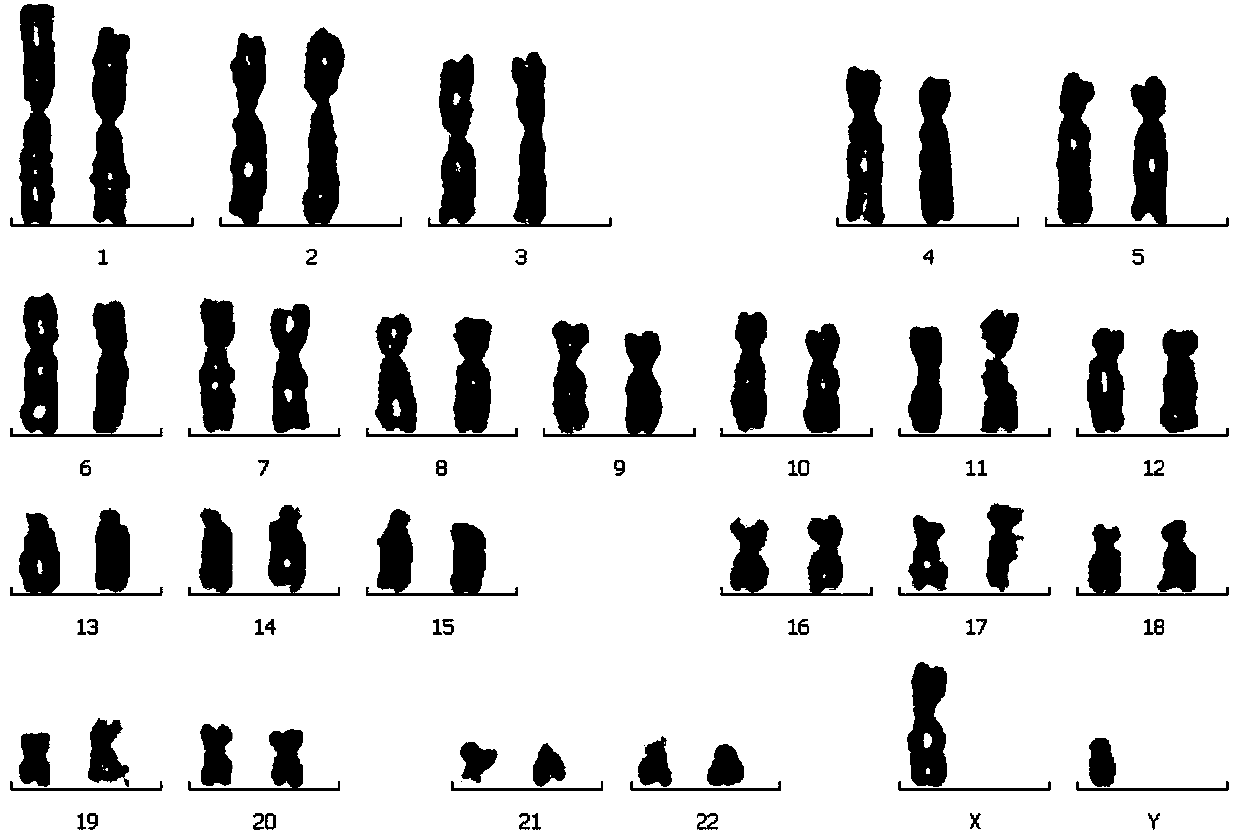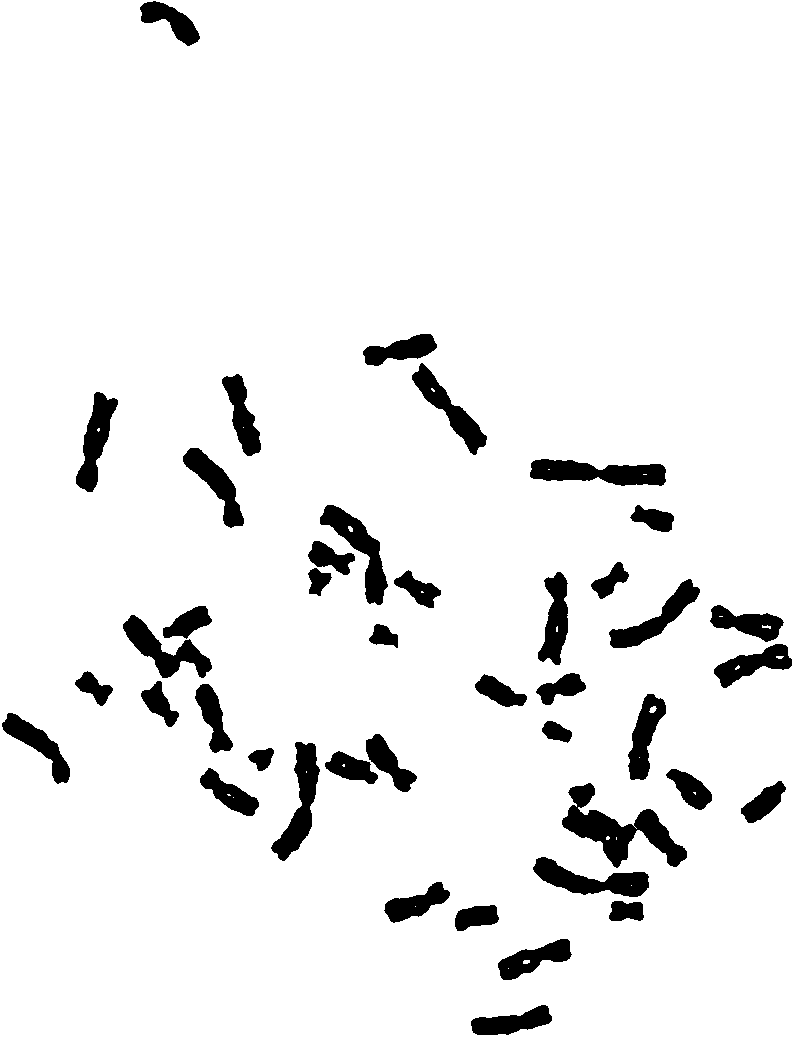Human embryonic lung fibroblastic cell SV-7 and application thereof
A technology of fibroblasts and SV-7, applied in the biological field, can solve problems such as poor growth status, increased production costs, and impact on virus production, and achieve good adaptability and high adaptability
- Summary
- Abstract
- Description
- Claims
- Application Information
AI Technical Summary
Problems solved by technology
Method used
Image
Examples
Embodiment 1
[0045]The acquisition and karyotype analysis of embodiment 1SV-7 cell line
[0046] Obtaining of 1SV-7 cell line
[0047] from having as Figure 1A and Figure 1B The edge of the lung tissue was cut into pieces of about 1mm from a 14-week-old male embryo with the indicated karyotype 3 Rinse the tissue pieces with PBS solution (pH 7.2) for 2 minutes, discard the supernatant, and repeat 3 times. Digest with tissue digestion solution containing 0.2% type Ⅰ collagenase at 37°C for 30 minutes. Oscillate once every 8 minutes, pipette with cell growth medium containing 15% fetal calf serum, and separate the cells until no obvious visible tissue pieces. Filter the cell suspension through a 100-mesh stainless steel screen and centrifuge at 1000-1200 rpm for 5 minutes. Resuspended to a cell density of 5×10 5 / mL, transfer to T75 cell culture flask, place at 36.5±0.5℃, 5%CO 2 Cultured in an incubator. After treatment with 0.25% trypsin, the cells were continuously cultured. The ...
Embodiment 2
[0061] Example 2 Adaptability of varicella-zoster virus in SV-7 cell line
[0062] Inoculate the working seeds of Oka strain varicella zoster virus (from ATCC, No. VR-795) to SV-7 and MRC-5 cells at an MOI of 0.001, and place the cell bottle inoculated with the virus at 35.0±1.0°C for 1 hour to adsorb , shake once every 20 minutes; after the adsorption is completed, add virus maintenance solution, and place in a 35.0±1.0°C incubator to continue culturing. In order to ensure the growth of cells and viruses, the virus culture medium was replaced every 48±4 hours during the virus culture process, and the virus culture medium was changed on the 12th, 24th, 36th, 48th, 60th, 72nd, 84th, 96th, 108th, 120th, and 132nd days after inoculation respectively. , 144, 168, 192 and 216 hours under the microscope to observe and record the disease state, discard the culture medium and wash the cell surface with PBS solution, then add PBS solution, freeze and thaw the cells, and use the microcy...
Embodiment 3
[0063] The adaptability of embodiment 3 rabies virus in SV-7 cell line
[0064] 1. Culture the human diploid cell line SV-7 obtained in Example 1 into a dense monolayer, digest with 0.25% trypsin, and use medium such as MEM, EMEM, DMEM, M199 and L60 containing 10% bovine serum collected and prepared into 3 x 10 5 cells / mL cell suspension, inoculate the rabies virus CTN-1V strain into the cells according to the MOI of 0.01-0.1, add virus maintenance solution, culture at 33°C for 13 days, observe cell changes, replace the virus maintenance solution every 2 days, and harvest The cell supernatant was used to detect the virus titer. Table 3 is the titer result of rabies virus inoculated with SV-7 cells of different passages.
[0065] The titer result of the rabies virus cultured by the SV-7 cells of different passages in table 3
[0066]
[0067] 2. Virus passaging stability: After the virus was cultivated for 9 days, the virus liquid was harvested and used as rabies virus se...
PUM
| Property | Measurement | Unit |
|---|---|---|
| Titer | aaaaa | aaaaa |
| Titer | aaaaa | aaaaa |
Abstract
Description
Claims
Application Information
 Login to View More
Login to View More - R&D
- Intellectual Property
- Life Sciences
- Materials
- Tech Scout
- Unparalleled Data Quality
- Higher Quality Content
- 60% Fewer Hallucinations
Browse by: Latest US Patents, China's latest patents, Technical Efficacy Thesaurus, Application Domain, Technology Topic, Popular Technical Reports.
© 2025 PatSnap. All rights reserved.Legal|Privacy policy|Modern Slavery Act Transparency Statement|Sitemap|About US| Contact US: help@patsnap.com



